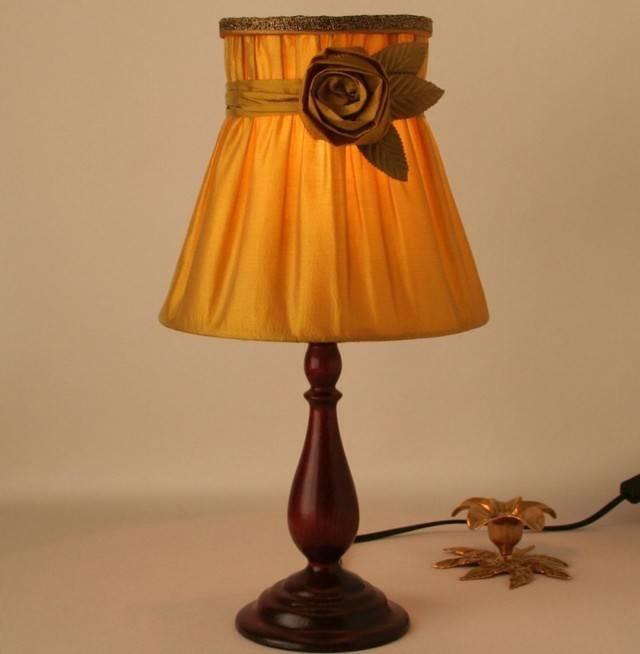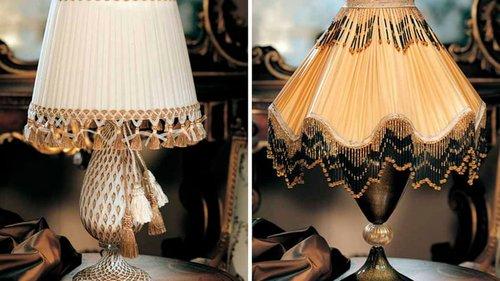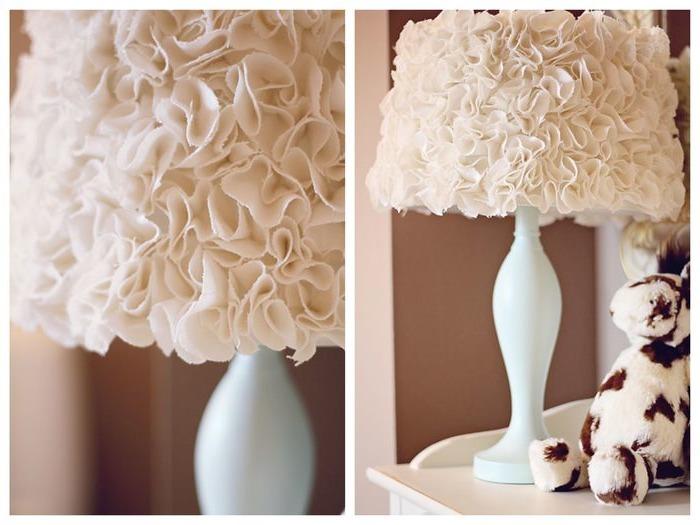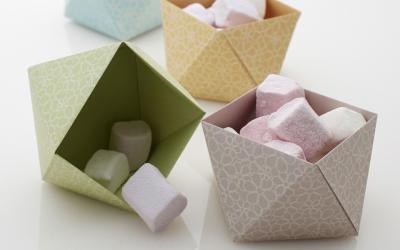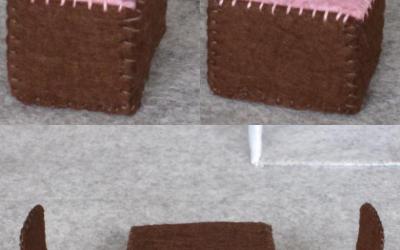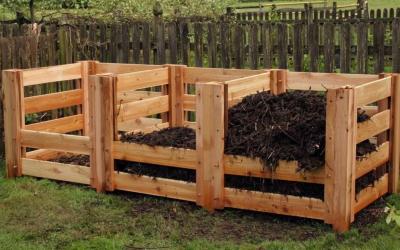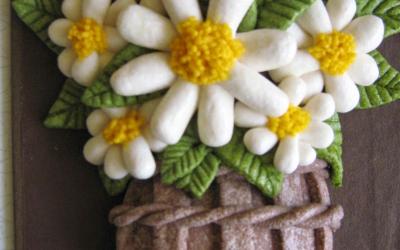How to make a lampshade for a table lamp
After the repair in the house, things that have served for many years may not fit the new interior. If some can be exchanged for new, then there are those that are a pity to throw away. For example, a desk lamp has remained in working order. But in terms of its external characteristics does not fit the new design at all. Try to freshen up the object by making it a new lampshade. Give the old thing a chance to sow in a different way. Lampshade for a table lamp, made with your own hands, you can think up yourself or use the ideas of craftsmen. About the secrets and subtleties of the work, the materials from which the lamp can be updated, as well as detailed instructions for the manufacture, read below.
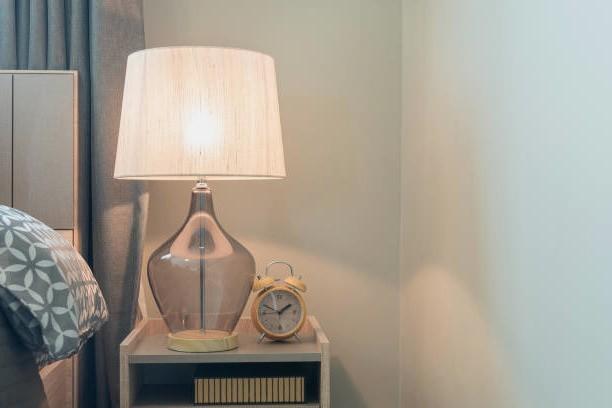
Lampshade for a table lamp with their own hands
Light fixtures in the room serve not only as an element of decor. They should give quality lighting. Table lamps - additional light for desks, bedside tables.
A variety of materials can be used as a material:
- paper;
- fabric material of different textures;
- beads;
- lace;
- wallpaper;
- netting;
- artificial flowers, etc.
Made with your own hands, the lampshade will perfectly complement the interior. Completely transforming the look of the lamps with your own hands, you can dilute the decor with a creative touch, make it original.

How to choose a fabric for a lampshade
Decided to make a lampshade from fabric, choose a sturdy fabric. Determine what kind of light you need: warm, cool, bright, muted. Use this as a guide when choosing the color and density of the material. If you want warm light as a result, choose a yellow, red or orange color fabric. If cool, use green, blue, or purple. The denser the material, the less light it will let in and vice versa.
Lampshade with your own hands is sewn from:
- cotton;
- linen;
- burlap;
- silk;
- taffeta;
- Multicolored scraps.
Note: It is good if the material will be impregnated with a means that repels moisture and dust. Ideal in terms of safety will be non-flammable fabrics. You can find such in specialized outlets.

Read Also about making a dress out of paper with their own hands.
How to make a frame for a lampshade
To work, you need a plafond frame. The shape of the construction can be semicircular, cylindrical, square, conical, rounded. For beginners, it is easier to construct a cylindrical or cone-like.
You can use an old construction, having previously cleaned it of any paint chips. Paint, choosing a shade of paint to match the shade of the lampshade, so the base will not be too conspicuous.
If there is no frame, and the old one has fallen into disrepair and it is impossible to use it again, you can buy an inexpensive version of the lamp and use its base under the lampshade. Some craftswomen use trash cans (plastic or wire) as lampshades, having previously treated them. If the size of this option suits you, feel free to take it into action. At the bottom of the basket is made a hole for the cartridge and wires, then you need to decorate the lampshade.
For the frame also use other materials.
- Mesh made of wire. The ideal cylindrical plafond will turn out from this material. It is desirable to take a thin mesh. Cut the desired width and length. The place of the cut is formed at the base of the vertical struts, so that the result is the long horizontal ends. Fold the mesh into a ring. Secure with the ends of the remaining wire. The frame for a lamp shade is ready.
- Wire. Use steel or aluminum wire. To work need pliers or pliers, wire cutters. Two rings are made from the wire, which are connected by posts. The size of the rings depends on the future appearance of the plafond. Number of posts affects how the material will lie. Make a lot of them, the lampshade will lie smoothly and evenly. Method for mounting the pole and ring selects, taking into account the wire used and its thickness. If it is thin, make hooks on the ends, which are clamped with pliers. All sharp parts of the wire are ground with coarse sandpaper. If the diameter of the wire is more than 1 mm, use welding. The wire frame is painted to match the general shade, wrapped with thread or tape.
- Bottle made of plastic. Take containers of large liters (from 5 liters). Depending on the shape of the future lampshade, the bottom or top is suitable. In the cut off part of the container make a notch for the cartridge or use a neck for this purpose. Cut out the excess plastic along the lines drawn beforehand with a marker. Make rims and posts. The frame is ready. It remains to decorate the lampshade.
When the frame is ready, proceed to the manufacture of the lampshade for the table lamp.
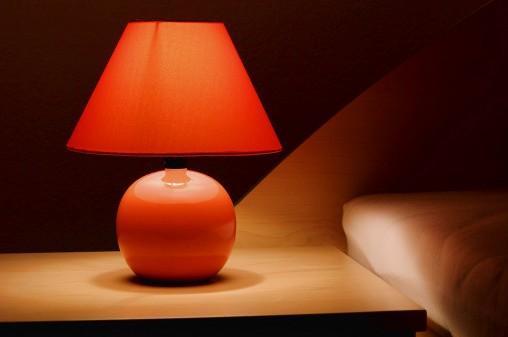
Step by step master class on making a lampshade from paper or fabric
You do not need special skills or special devices to make a lampshade from paper. The fabric version is made without using a sewing machine. Paper lampshades are good that they can change even every month, complementing your interior with new elements in the decor. Know techniques of origami, papier-mâché, paper cutting, change and create new creative ideas with a lamp. But one of their disadvantages is the short-lived paper construction and difficulty in care.
Pattern
For a fabric lampshade, make a pattern out of medium-weight paper (absorbent cotton is ideal):
- Wrap the paper around the frame of the lamp;
- tape the joints together;
- Remove excess paper at the top and bottom with scissors;
- Remove the paper cover from the plafond;
- Cut it lengthwise.
The pattern is ready.

Making the cover
Place the paper pattern on the wrong side of the selected fabric. Put a chalk outline with an allowance of 2 cm. Cut out the desired length of fabric. The allowances wrap inside the wrong side. Iron to smooth out.
The blank of the cover is ready.
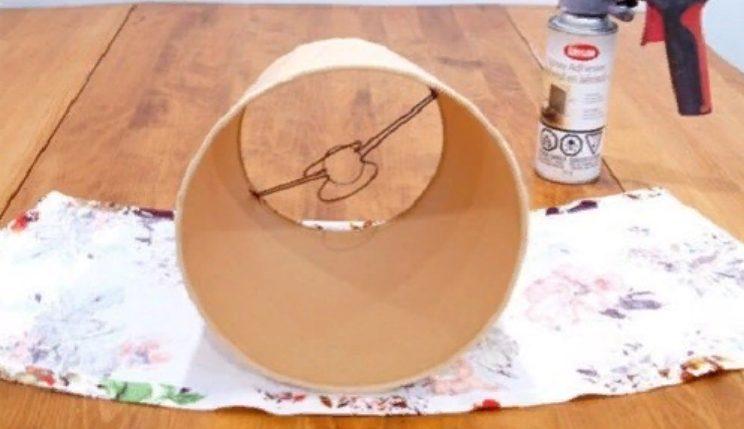
Fastening of the cover to the frame
We take a frame for the lampshade and wrap the fabric blank around it. The joint can be glued or sewn with a needle. Stitch neatly, you can use a decorative stitch. The allowances are wrapped inside the frame and glued. To do this, use PVA glue or a special double-sided adhesive tape for sewing (you can find it in specialized stores).
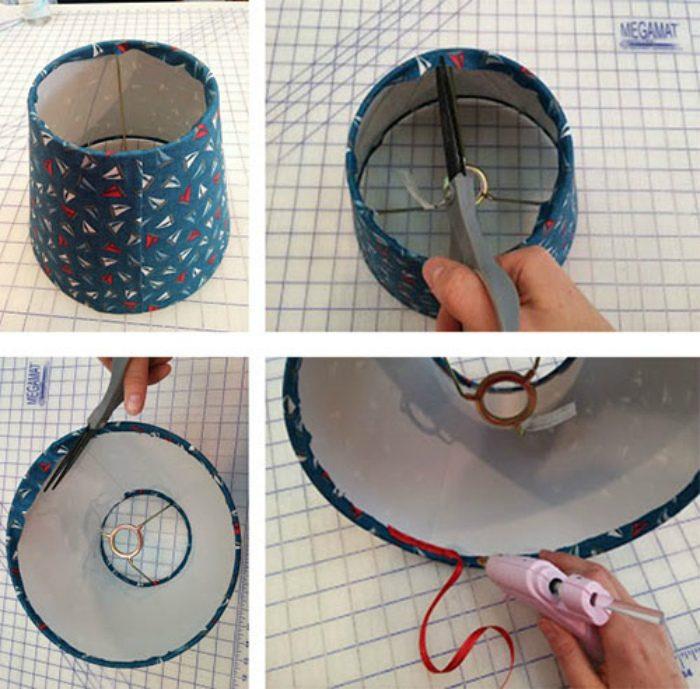
Other types of lampshades
As a lampshade use hand-crocheted napkins, strips of ribbons, twine, yarn. In general, any material. As long as you have imagination and creative ideas. Lampshades from disposable spoons and paper plates, plastic bottles will be original. Let's dwell on them in detail.
Lampshades from disposable spoons
As a result of working with such material, you can get a creative lamp shaped like a pineapple. For the work, we use a frame made of a plastic bottle. It perfectly fits the shape of the fruit. But if there is another version of the plafond with similar outlines and dimensions, use it.
To make it, prepare:
- plastic spoons (the size of table spoons - 100-125 pieces, the size of tea spoons - about 200 pieces);
- a glue gun;
- sharp knife;
- acrylic paint (yellow);
- green cardboard.
Prepare the spoons. Cut off the part to be held, leaving up to 2 cm tails at the base. The convex part of the spoon is painted yellow. It is better to use acrylic paint. It goes well the first time, dries quickly and is odorless.
Start assembling the lampshade. Apply a small amount of glue to the remaining tails. Glue to the bottom of the plastic bottle, tightly together. The painted side of the spoons should be turned towards you. Allow to dry and set.
Do the second circle and subsequent ones using the same technique. But we place the spoons overlapping the previous row, in staggered order.
Decorate the top of the plafond. From the green cardboard cut a circle. Inside it we make a hole that coincides in diameter with the top hole in the bottle-frame. The outer circle of cardboard should be wide (at least 10 cm). On this side we make big teeth with scissors. Glue the blank on top of the frame with spoons.
Cut out of cardboard pineapple leaves in an amount of 7-9 pcs. Insert them into the upper hole of the plafond. Glue. At the base make a small ribbon of the same cardboard and wrap the leaves, without pulling them down.
As a result, you will have an original table lamp, which can be used to decorate a child's room or dining table.

Read Also about creating a fabric bag with your own hands.
Tiffany lampshade from a plastic bottle
Tiffany style is a stained glass mosaic. You can make a table lamp, imitating this style, using a plastic bottle as the basis. Preparation of the container will be similar to the preparation of the frame. But in this case, the lampshade is performed with paints exactly on the plastic of the container.
For the work we will prepare:
- a sharp knife;
- outline paint (gray, gold, white);
- acrylic paint in different shades.
Leave the bottom edge of the bottle flat or think of a simple ornament. Draw the pattern on the plastic with a marker. Follow the outline with outline paint. Leave to dry.
Brush the remaining open plastic. Use different shades of paint. Some areas can be left unpainted, increasing the light output of the lamp.
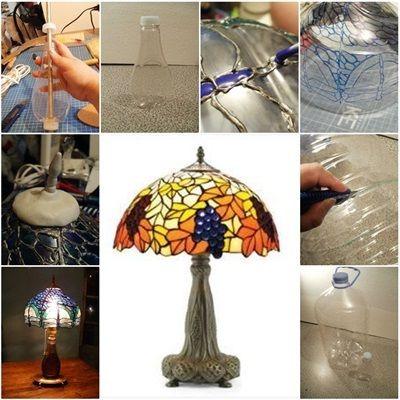
Lampshade from paper plates
How to make a lampshade out of paper plates? This method of decorating a table lamp is perfect for any cylindrical frame. You can find paper plates of any color on sale, which gives you the opportunity to make a lampshade bright or more tranquil.
Calculating the number of plates: each centimeter of the frame circumference will require one plate.
Prepare blanks of plates:
- bend in half;
- From the resulting line of the fold measure with a ruler 0.5 cm on both sides and draw lines parallel to the fold;
- Apply a ruler and do not sharp, but a sharpened object along these lines;
- Fold along the resulting corrugated lines.
As a result, you get a folded paper plate with a base at the point of fold in 1 cm. Drop glue from a glue gun on the folded area and glue each piece close together to the frame.
At the end of the work you will get a volumetric spherical lampshade.

Lampshade from threads
In the manufacture of a model with threads frame is not required. His role will be taken by the threads. For the work you need:
- balloon;
- PVA glue;
- Vaseline;
- large needle;
- scissors;
- threads.
Balloon inflate to the required size - the diameter of the lamp. At the foot (where the tail) marker draw a circle with a diameter equal to the size of the future lamp holder. Lubricate the surface of the ball with vaseline. Thread the thread through the needle. We punch a tube of glue through the middle. Remove the needle from the thread. You have a thread that goes through the tube, smeared with enough PVA. This is the easiest and "cleanest" way.
The beginning of the thread can be attached to the tail of the ball. Start wrapping it in any order. Try not to get the thread into the ring marked with a marker. At the end, attach the end of the thread to the ponytail and glue it on top. Allow to dry completely. We burst the ball, remove it. This leaves a framework of thread, which we attach to the chuck.
Variety such a lampshade can be, using threads for wrapping of different textures or colors.

A few words about safety
Do not forget about the rules of safety when using homemade lampshades. In the industry, they take into account the calculation of the power of radiated heat from the lamp and the type of material from which the lamps are made. In order not to bother with this when creating a lampshade with your own hands, adhere to these rules:
- Do not use simple incandescent lamps in the lamp, LED or "economy" lamps will do;
- Replace the metal socket with a plastic or ceramic one (they take a certain percentage of the heat);
- If you use a flammable material (cardboard, synthetics, or cotton), the distance to the bulb should be at least 7 cm.
Important! When a new lamp shade is installed, do not leave the lamp on unattended for the first time. Watch for a possible increase in temperature. If you feel the lamp shade heating up, replace the bulb with one with a lower wattage setting. Observe again. If all is well, you can safely use it.
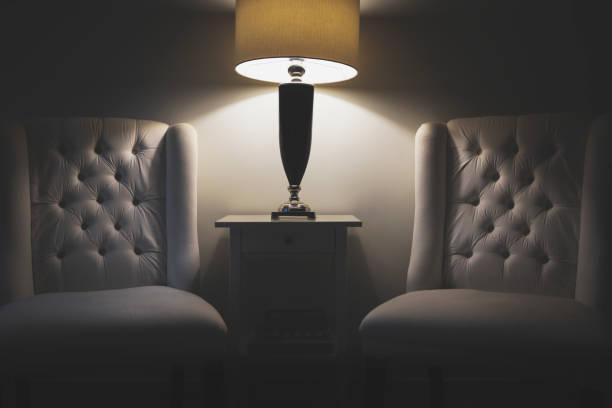
Photo ideas for an interesting table lamp shade

